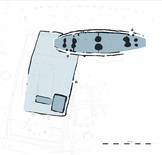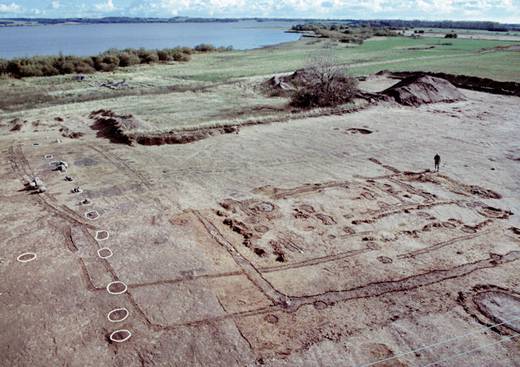The magnate’s residence at Tissø
Excavations and finds
The excavated magnate’s residence at Tissø has produced much evidence suggesting that it was a ritual complex.
Between 1995 and 2003 large-scale excavations were undertaken at Tissø, in which 85,000 m² of the inhabited area of 500,000 m² was investigated.
The excavations identified two magnate’s residences with associated trading and craft areas. The oldest of the two magnate’s dwellings is from the middle of the 6th century and lies within the enclosed area of 10,000 m². The main building is 40 metres long and very sturdily built.
During the excavations of the large buildings clear evidence was found of a fire that occurred in the late 7th century. After this a new magnate’s dwelling was erected c.600 metres to the south. The new residence was demolished in the 11th century. It increased in size during four phases. The first two phases, in the 8-9th centuries, show a complex which gradually grew in size, both in terms of area and the total number of buildings.
The core of the complex was a great hall covering c.350 m². The finds from the hall are striking. They show that banquets and significant activities took place in its eastern part, whilst the western area was probably used for more private purposes.
Structures with ritual functions
In the area around the hall remains were found of a number of structures that may have been used for ritual purposes. Immediately north-west of the hall was a large pile of stones covering many cubic metres. There were no finds or traces of charcoal or sooting present, although the stones showed evidence of heating. Similar piles of stones have been found elsewhere, at sites such as Lejre and Järrestad in South Sweden.
A further interesting area was discovered in the northern part of the manor complex. Here a thick archaeological layer was found near the forge, containing animal bones and objects, including newly produced fire lighting implements, sickles and other tools. Such finds do not represent ordinary waste and may been deliberately deposited.
When the second phase of the magnate’s residence at Tissø is analysed we are struck by the fact that the manor contained numerous buildings and structures connected with pre-Christian cult rituals. On the basis of the finds that they produced the three pit-houses may also have functioned as ritual structures.
Facts:
Settlement area: c.500,000 m².
Excavated area: c.85,000 m².
Total number of house sites: c.50 houses and 80 pit-houses. Including a large hall measuring 12 x 48 m and two earlier halls covering 8-10 x 36-40 m.
Finds: c.12,000. Many gilded silver and bronze objects, weapons, coins, trading weights and silver fragments.
Faunal material: over 200 kg of bone.



